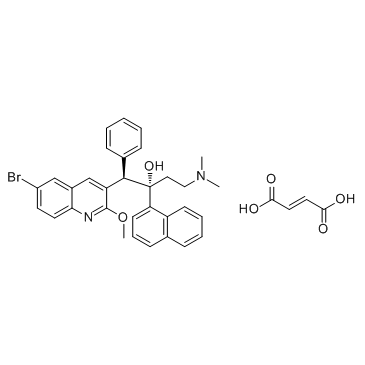All AbMole products are for research use only, cannot be used for human consumption.

Bedaquiline inhibits the growth of TDR M. tuberculosis strains, with MIC values ranging from 0.125 to 0.5 mg/L. Among slowly growing mycobacteria (SGM), bedaquiline exhibits the highest activity against Mycobacterium avium with MIC50 and MIC90 values of 0.03 and 16 mg/L, respectively. Among rapidly growing mycobacteria (RGM), Mycobacterium abscessus subsp. abscessus (M. abscessus) and Mycobacterium abscessus subsp. massiliense (M. massiliense) seem more susceptible to bedaquiline than Mycobacterium fortuitum, with MIC50 and MIC90 values of 0.13 and >16 mg/L, respectively, for both species. Bedaquiline also shows moderate in vitro activity against NTM species. Bedaquiline has an excellent in vitro activity against Mycobacterium tuberculosis, including multidrug resistant M tuberculosis.
| Cell Experiment | |
|---|---|
| Cell lines | M. tuberculosis |
| Preparation method | M. tuberculosis was cultured in 7H9 broth and grown to an A600 nm of 0.8. Cultures were treated with 0.1, 1 or 10 mg ml 1 BDQ for 24 h. NADH and NAD þ concentrations were determined and the NADH/NAD þ ratio was calculated as described. |
| Concentrations | 0.1, 1 and 10 mg/ml |
| Incubation time | 24 h |
| Animal Experiment | |
|---|---|
| Animal models | BALB/c mice |
| Formulation | |
| Dosages | 25 mg/kg |
| Administration | i.v. |
| Molecular Weight | 671.58 |
| Formula | C36H35BrN2O6 |
| CAS Number | 845533-86-0 |
| Form | Solid |
| Solubility (25°C) | 10 mM in DMSO |
| Storage |
Powder -20°C 3 years ; 4°C 2 years In solvent -80°C 6 months ; -20°C 1 month |
| Related Antibiotic Products |
|---|
| Puromycin-d3
Puromycin-d3 is the deuterium labeled Puromycin. Puromycin dihydrochloride is the dihydrochloride salt of puromycin. Puromycin is an aminoglycoside antibiotic that inhibits protein synthesis. |
| BSH-IN-1
BSH-IN-1 is a potent and covalent inhibitor of gut bacterial recombinant bile salt hydrolases (BSHs) with IC50s of 108 nM and 427 nM for B. longum BSH (Gram positive) and B. theta BSH (Gram negative), respectively. |
| AAA-10
AAA-10 is an orally active gut bacterial bile salt hydrolases (BSH) inhibitor, with IC50s of 10 nM, 80 nM against B. theta rBSH and B. longum rBSH respectively. |
| Gut restricted-7
Gut restricted-7 (GR-7) is a potent, covalent and orally active pan-bile salt hydrolase (BSH) inhibitor. Gut restricted-7 has a tissue-selective and is restricted to the gut. Gut restricted-7 decreases gut bacterial BSHs and decreases deconjugated bile acid levels in feces of mice. |
| N-Hydroxypipecolic acid
N-Hydroxypipecolic acid (1-Hydroxy-2-piperidinecarboxylic acid), a plant metabolite and a systemic acquired resistance (SAR) regulator, orchestrates SAR establishment in concert with the immune signal salicylic acid. N-Hydroxypipecolic acid accumulates systemically in the plant foliage in response to pathogen attack. N-Hydroxypipecolic acid induces SAR to bacterial and oomycete infection. |
All AbMole products are for research use only, cannot be used for human consumption or veterinary use. We do not provide products or services to individuals. Please comply with the intended use and do not use AbMole products for any other purpose.


Products are for research use only. Not for human use. We do not sell to patients.
© Copyright 2010-2024 AbMole BioScience. All Rights Reserved.
